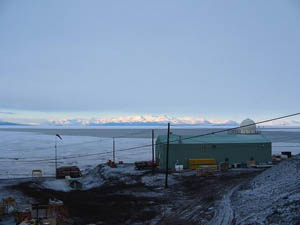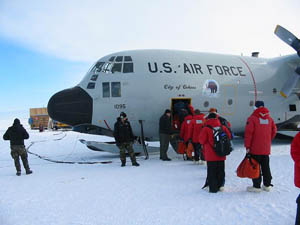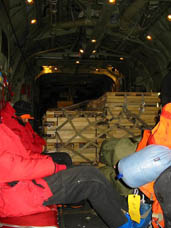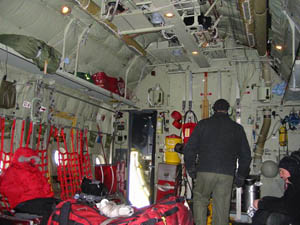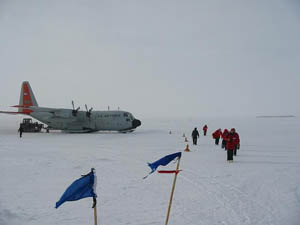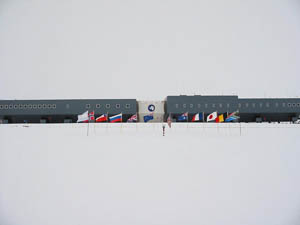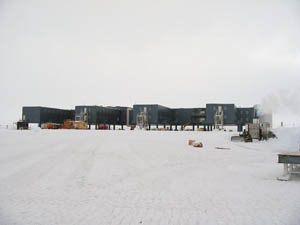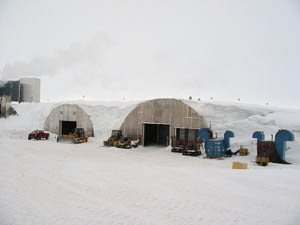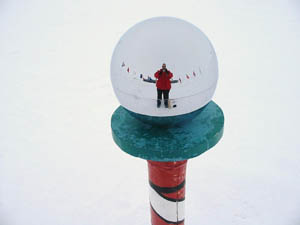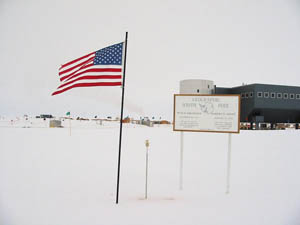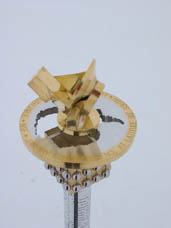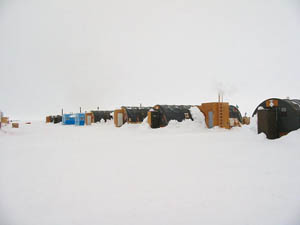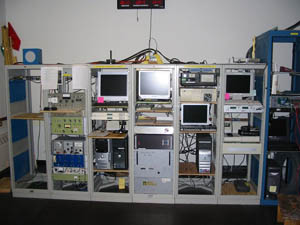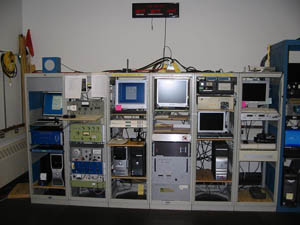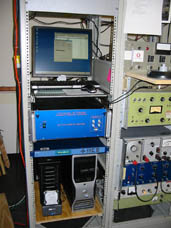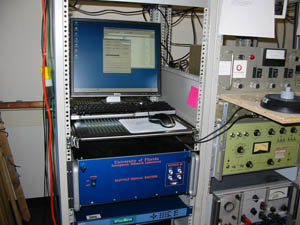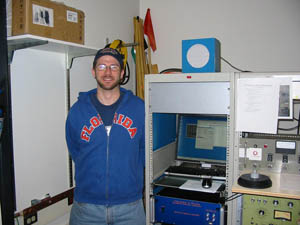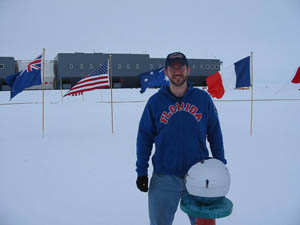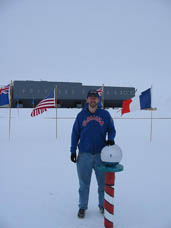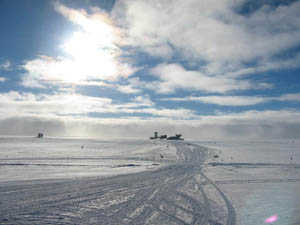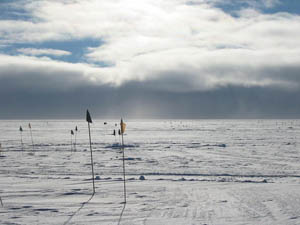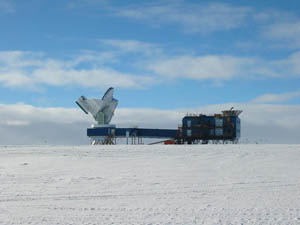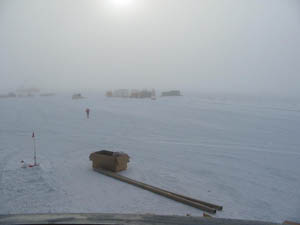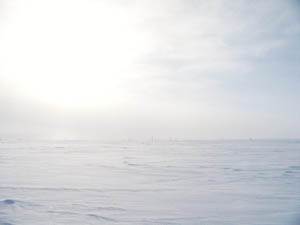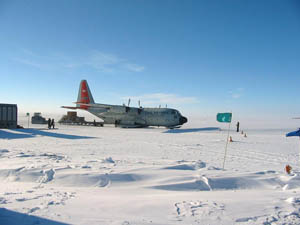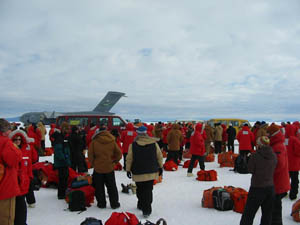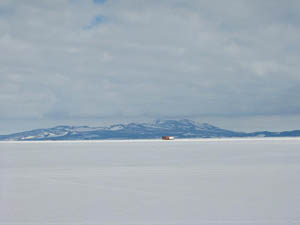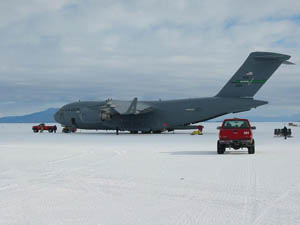McMurdo/South Pole Field Report 2010
This is a deployment blog chronicling Dr. Robert Moore's deployment to McMurdo Station/Arrival Heights and to Amundsen-Scott South Pole Station/CUSP Lab in 2010. Dr. Moore will be "on the Ice" from 26 January 2010 through 8 February 2010, but he will also post bits about his torturous route from Florida to Australia and to New Zealand on his way to and from the Antarctic continent.
21 Jan 2010: Florida
Robb Moore signing on. Tomorrow I leave at about 7:30 am from Gainesville to drive to Jacksonville in time for an 11am flight to Miami. This will get me started on a more than 30-hour trip to Christchurch, New Zealand. In Christchurch, I'll be issued cold-weather gear and prepare for the flight to McMurdo Station. It will be the 26th by the time I depart -- it's a day ahead of Florida in that part of the world. So hopefully, I'll be able to post a few pictures from Christchurch and a few close-ups of Antarctic gear on the 25th or so. In the meantime, wish me a safe journey, and I'll be in touch in a couple days.Cheers, Robb
24 Jan 2010: In Christchurch, NZ
Suffice it to say that this was a long journey -- 38 hours after leaving home, I am now in my hotel in downtown Christchurch. I'm happy to not be on a plane or in an airport anymore. The airlines left one of my bags in Sydney, but apparently they are "aware of the situation," and they will deliver it to my hotel later tonight. So I'm a bit edgy -- my neck aches, my back hurts, and I could really use a change of clothes, but my bag's in Sydney still. But I will give tremendous credit to Qantas airlines for serving food in-flight that was better than anything I found at either Miami or Los Angeles airport. At any rate, I'm grateful to have a day or two in NZ for Antarctic clothing issue at this point -- it's just as much for recovery from travel fatigue, if you ask me, and it is definitely needed.Moving on, now I'm in downtown Christchurch, staying at the Camelot Hotel at Cathedral Square. New Zealand is beautiful, and it's summer time here. Of course, for my two days this time around, it's overcast... I've been to New Zealand three times, and this is by far my shortest visit. One place I've tried to visit each time I've been here is Rutherford's Den, but until today, I've never succeeded to get inside. Ernest Rutherford is, of course, one of the world-famous scientists from the early 20th century that pioneered work in radioactivity. Although much of his work was performed abroad, he was a New Zealander, and they've kept up the basement lab he used here at Canterbury College in the late 1800's. This is the guy that first identified and named alpha, beta, and gamma rays, among his many accomplishments. One little-known-fact about Rutherford is that for a period of time, he held the world record for the long-distance transmission of radio waves -- and this should explain, in part, one of my interests in Rutherford: one of the reasons for my trip to Antarctica in 2010 is to detect and analyze radio waves emitted by lightning in Florida, some 14000 kilometers away.
I posted a few pictures below -- click on them for the big picture.
Robb
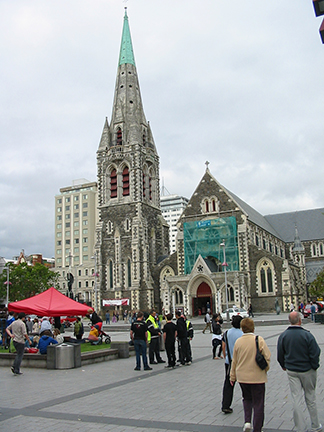









25 Jan 2010: In Christchurch, NZ
Good news: My bag arrived this morning, so I am now pretty much ready to depart for Antarctica. I swung by the electronics store to pick up a couple of last-minute items and I headed over to the Clothing Distribution Center (CDC). I was issued my Extreme Cold Weather Gear (ECW), and over the course of about an hour, I tried it all on to make sure it fit well. I've posted a couple pictures of it -- it doesn't look like much more than some good skiing clothes, but in reality, this stuff is warm and it's as light as can be. In addition to what's shown, we were issued long-johns, mittens, wool socks, and multiples of pretty much everything.I also took a couple shots of the US Antarctic Program (USAP) terminal here. See below. Today I was planning to visit the Antarctic Center, which has a terrific gallery filled with introductory displays about Antarctica and Antarctic research, but as you can see from the photo below, the line outside was pretty long, and I have a lot to do to prepare for tomorrow. Hopefully I'll be able to visit it on my way back home and share some pictures.
Tomorrow, I report to the terminal at 0600 hours to check in my bags, change into the new gear, and get ready to go. Flying out depends on the weather in Christchurch, but mostly on the weather in Antarctica, which can change rapidly. So there is a chance that our flight gets canceled tomorrow morning. There is also a chance that we fly out, get half-way to McMurdo, and turn around due to poor weather at McMurdo. This is called a "boomerang" for obvious reasons: the first is that you go out and come back; the second is that it can cause you a tremendous amount of pain and suffering, especially if it happens a few days in a row. Of course, it's better than landing in poor conditions....
26 Jan 2010: Christchurch, NZ to McMurdo Station, Antarctica
I am now safe-and-sound at McMurdo Station, Antarctica. It was about a 5-hour flight from New Zealand on a US Air Force C-17, and everything went smoothly. We have gone through an extensive set of orientation presentations, all with a tremendous emphasis on safety. Tomorrow, I start the day with a science briefing for our project (A-109-M/S/P), and until then, the research associate is tracking down the equipment we shipped, and I am checking the equipment I hand-carried. I picked up my bags, got settled in my office, and found my room. After being cooped up for what seems like three days straight, I took a hike out to the point to get my blood flowing again. It turns out that it's not too cold here right now, and really the weather is quite pleasant, all things considered. I don't know the temperature off-hand (somewhere just below freezing probably), but I'll post some more details on that in the upcoming days. In less than a day on-site, I've seen several penguins, a whale, and a seal, and I caught them all on camera. It's lucky that it happened today, because the rest of the week will be spent working hard on the receivers. I posted a few more pictures below, and this time I've provided some short captions.
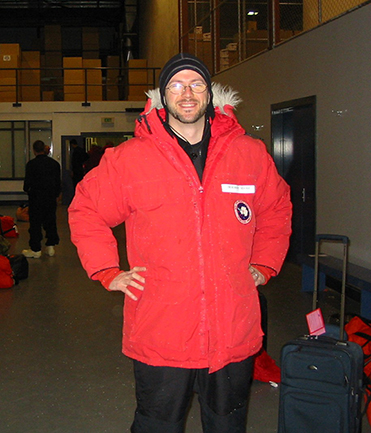












27 Jan 2010: McMurdo Station, Antarctica and Arrival Heights
It has been a long, difficult work day focused on fixing up the ELF and VLF receivers at Arrival Heights. The first goal is to fix any problems with the receivers themselves, since there's no replacement for good data, followed by installing the new equipment and data acquisition unit. I've put together a brief set of field notes for today, and they are available in PDF format here, for those of you who are interested. I took a few photos, posted below, and I realize now that I didn't actually take a picture of the building at Arrival Heights, so that will come later. Arrival Heights is a specially protected area in Antarctica about a mile from McMurdo Station, with the goal being to be as electromagnetically quiet as possible (e.g., no radio broadcasts, etc.). So this makes for a fun hike to the VLF antenna, which is another mile or so further out, with my radio turned off. The VLF antenna is situated in a small crater (see below). I took pictures, but in the time it took me to get there, a thick fog bank moved in, obscuring all views of everything. Shortly after the picture taken below, I couldn't see the antennas anymore, even. Actually, this was a lot of fun, since I knew it was a fog bank rather than bad weather, in which case it would not have been fun. After that, all pictures would have been pure white, so there isn't much more to add in for today.That being said, I've posted some more pictures from yesterday. I was able to actually enter Discovery Hut out at the point (near where I saw the whale and seal). This is not a special deal, but it has to be arranged to get in, and it is well worth it. The hike is maybe about a mile round-trip from McMurdo, and it's an easy one. But after all that flying, an easy hike was the way to go to get my joints greased up again. Discovery Hut was built by Commander Robert Scott during the Discovery Expedition in 1902, and it is still standing. It served as a staging ground for a number of Antarctic expeditions over the years. What's inside is primitive... well maybe not primitive, but certainly old. There are some old canisters of provisions, some rotting (and very old) seal parts, various articles of tattered clothing, oil lamps, and various furniture. Put this all together inside a creaky old building that really has no business standing for over 100 years, let alone standing in Antarctica for over 100 years, and you've got yourself Discovery Hut. Commander Scott, of course, is the famed Antarctic explorer. Although he organized a number of expeditions, he is probably most notably associated with the Terra Nova Expedition 1910-1913, which ended up being a race to the South Pole between Roald Amundsen's team and Scott's team. Amundsen beat Scott to the Pole by 5 weeks, and all 5 of Scott's team perished on the return trip from the Pole, after having discovered Amundsen's flag at the Pole waiting for them.
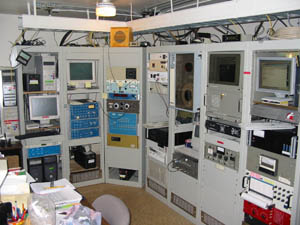
30 Jan 2010: McMurdo Station, Antarctica and Arrival Heights
So it has been a couple of days since I've been able to post. I've been very busy up at Arrival Heights getting our system working (field notes here). The weather was pretty bad a couple days ago (on the 28th), then it was beautiful (on the 29th), and today it's just OK. I've found out that the minimum temperature since I've been here was about 25 degrees Fahrenheit, and the maximum was about 40 degrees. So it's pretty nice. At the same time, the wind blows pretty steadily, and it feels colder than it is. At one point, I was outside at Arrival Heights, leaning on the wind and making a 30-40 degree angle from vertical with no effort. That's pretty fun, as long as you don't have to hike anywhere with the wind in your face.
So let me start with 28 January and play catch up. To the right, there's a picture of what the weather was like (note the flags to gauge the wind). This was taken during the van ride from station to Arrival Heights. The VLF antennas are situated in that crater you see lying straight ahead in the photo. Nice. This crater is known as Second Crater: it is the highest point in Arrival Heights (255 m) and it delineates (or very closely delineates) one of the boundaries of the protected area that is Arrival Heights. Second Crater is essentially an inactive volcano formed by the active volcano Mt. Erebus, which is nearby. To quote SCAR (the Scientific Committee on Antarctic Research), "the basaltic rocks are particularly rich in ultramafic inclusions, including dunite, peroditite, pyroxenite, gabbro and sandstone. The soil consists mostly of volcanic scoria overlying volcanic tuffs from Mt. Erebus, with rocky and weathered volcanic magma." Now, I may not be a geologist, but in case you didn't know, it's painful to hike on basaltic rocks that are rich in ultramafic inclusions, even in good weather. And don't get me started on the volcanic scoria... This picture pretty much summarizes the 28th. I stayed inside and worked on the electronics.
On the 29th, the weather was excellent. So I immediately hiked up Second Crater to finally perform a full examination of the VLF system (the last trip ended early due to weather). I ended up with some pretty good pictures of the US shelter at Arrival Heights (as promised earlier) and Arrival Heights itself (see below). I examined the VLF antennas, which are triangular air-core magnetic loop antennas that stand 29.5 feet high. We have a preamplifier there to boost the signal levels before sending them down the cable to our computer back in the shelter. Due to the high winds at Arrival Heights, one thing I'm checking on is the cabling itself. The antennas break on occasion, and without a completed loop, we get no signal. So there are several antenna mends that I need to check out (these have been done using a couple sets of clamps, solder, and electrical tape for each mend), and I'm evaluating whether we need new antennas (for next year). The same goes for the cable that goes back all the way back to the shelter -- the casing wears over time. And actually, all tests indicate that it's time to change out this cable (or at least parts of it) for a new one.
After checking on the antennas, I've been almost continuously (through to today) testing and reprogramming our new data acquisition system. It turns out there's a nice bed up at Arrival Heights, and I've been using it to minimize travel time, bringing extra sandwiches with me from lunch and skipping dinner. We ran into several snags along the way (nothing new for field work), and at this point in time, all of the hardware for the new system has been fixed up, hopefully to operate for the rest of the year without any direct interaction from UF. While there is a research associate here who manages daily checks of the system, and we can connect to the computer remotely from UF, there is no way to get any new hardware to McMurdo for the rest of the winter, which is long here -- so this was our one shot for the year to get things right. As it stands right now, we are running our final operational tests, and they have been successful so far.
Tomorrow, I will continue with system tests, take pictures of the final setup of the instrumentation, and document all observations (a year from now, we won't remember so well). Tomorrow night I "bag-drag" (i.e., check in my bags for South Pole), and early the next day I fly to South Pole. So the time for any last-minute changes has officially past. We seem to be in good shape at this point in time.
31 Jan 2010: McMurdo Station, Antarctica and Arrival Heights
As of now, my work at Arrival Heights is complete. I leave for South Pole in about 4 hours (really I get the shuttle to the airplane then), so it was good that I chose today to wrap things up.... Our system is fully operational, with better timing and better dynamic range than it previously had. And it now has enough hard drive space to record all data from now through the end of the winter. I am now officially excited about searching this data for events during our upcoming rocket-triggered lightning experiments in Florida (as if I hadn't been before...). It's not quite all over with at Arrival Heights, though. I am scheduled to be back for a day to check on the system on the 7th, but the way weather works here, it's quite possible I could miss that chance.
The weather today was nice, though -- only a bit of snow in the morning. I took a pretty cool shot out my office window with the sun glinting off the distant mountains. Check it out.
But really today called for more work at Arrival Heights. I visited the ELF vault with Shaun Howard, the Research Associate who's here for the summer. All was in good shape (the ELF sensors are 1-meter diameter loop antennas, and they're buried to reduce the effect of wind, among other reasons). This was expected, since the signals are producing good data. So I finalized the data acquisition units and got them ready for the winter. I've posted a couple pictures below.
Actually, today's a pretty good day to be leaving McMurdo. The Re-supply Vessel arrives today, and everyone will be quite busy unloading and re-loading it. They've cordoned off the main areas for heavy machinery, so it's a good time to get out of town. I also couldn't help posting what appears to be an extraordinarily large GPS antenna, but it's not. I haven't had a chance to ask what this is yet....
All in all, it's been a good trip to McMurdo: we have an upgraded ELF and VLF system here, and we can fully control it from Florida. I can't wait to get back (in 6 days...).
1 Feb 2010: Amundsen-Scott South Pole Station
I have now arrived at the South Pole -- I will no longer be posting "large" versions of the photos, but I think I can get away with slightly bigger thumbnails than I've been posting... so click on the images still. As I got ready to leave McMurdo, I snapped a few last-second shots of the mountains. Then we hit the bus to the plane, shot out quickly, and landed safely at South Pole about 4 hours later. The actual elevation at South Pole is 9300 feet, and we just arrived from sea-level in about 4 hours. The rarefaction of the atmosphere at the poles contributes to the effective altitude, which I previously thought was about 13,000 feet, but according to a flier I have in hand right now, we can only say that it is "well over 10,000 feet"... With this much altitude change in such a short time, one of the upcoming battles I face at the Pole is with altitude sickness. So I'm battling my headache with a lot of water, and I'm about to take a nap and get some rest. People may not realize how serious the effects of altitude sickness can be -- they can get much worse than just headaches. You can get dizzy and nauseous (making it hard to solder, for instance), you can have trouble sleeping, and you can also have trouble breathing. It can also be fatal. So if my headache gets a lot worse, or if my lungs start to wheeze, or if I start to feel drunk (assuming I don't drink alcohol) and can't walk or speak well, I will need to seek medical attention immediately. This didn't happen to me in 2003, and I don't expect it to happen now... but it does happen here on occasion, and I think it's one more thing that highlights the extremity of this environment -- this is Extreme Science (... "Xience"?).
By the way, the New South Pole Station (which was finished shortly after I left in 2003) is absolutely amazing... it borders on luxurious, really, considering where we're at. It's -20 degrees F outside, and you wouldn't even know it. You can go out on the balcony (on the sunny side of station) in a T-shirt and still be pretty comfortable. I'll post more on the station in the upcoming days.
Also, the availability of Internet at the Pole is limited to a few hours per day. So you can expect my posts to come with a bit of a delay. In fact, I was rushing to get this post out before the satellites disappeared, but missed it by bit.... Oh well.
2 Feb 2010: Amundsen-Scott South Pole Station
I got a lot of sleep yesterday and woke up at about 3 am -- no headache, feeling great. I think it's the most sleep I've had in quite a while. So I went to the lab and got busy working. It seems that after the Arrival Heights installation, we are aware of most of the problems we'll face here at Pole in terms of electronics. So everything has gone smoothly so far. The computer is all set up, and the RAID array is working. I've identified the joints that need to be re-soldered, and I'll get to that tomorrow. It turns out they have an RF splitter here in the lab that's attached to a GPS antenna -- pretty smart considering everyone uses GPS to provide timing for their observations. So I'm going to install one of our super GPS receivers here (I had only brought it as a backup), and it's going to provide better timing resolution than the receivers presently in use here. So I'm happy about that.
After a long day's work, I took a hike around station. It's cold, but not too bad (-28 deg F with windchill). Really the tough part is the fact that it's so dry. My nose is absolutely dead. My lips are a bit raw, but not too bad yet. And you have to drink so much water to stay hydrated that, well... I know where every bathroom is on station already.
So let's start with the station. It became operational in 2003 for the first winter-over. It's called the South Pole Safety and Environmental/Station Modernization (SPSE/SM) upgrade, and it consists of a number of below-surface facilities (power plant, logistics, vehicle maintenance, fuel storage) in addition to the new elevated station. The elevated station is pretty interesting in itself. Why elevate it? It seems like a huge pain. But the reasoning is pretty solid. It doesn't snow much here at the South Pole -- it's mostly wind blowing surface snow around. This snow accumulates where buildings meet the ground and eventually covers everything. The new elevated station allows the snow to blow underneath it, so that it doesn't accumulate. This is what happened to the recently decommissioned South Pole Dome and there's a good picture on the right of some snow-covered vehicle maintenance silos.
The Pole itself is located very close to the station. There are two of them here -- one is a ceremonial Pole, with a lot of flags around it (the original signers of the Antarctic Treaty), and the other is the actual geographic South Pole, which drifts with time -- the USGS maps it out and marks it each year.
The ceremonial Pole has a nice barber-post style marker with a reflective globe on top -- you can see me in the picture to the right, and you can see a zoomed out photo above with the station in the back ground showing all the flags.
The geographical South Pole is marked with a special marker and a sign that commemorates Amundsen's and Scott's journeys to this point. Since the geographic Pole drifts, there's a new one for each year, and I posted a zoomed-in version of this year's on the right. I can't tell what it's supposed to be yet -- I'll have to ask around about that. I see an outline design of Antarctica in there, but I don't know what's on top of it. There's always some special meaning.
Lastly, to round out our tour, some pictures of the places I've spent a lot of time in. The first is a picture of the Jamesways. This year, I'm staying in the new station (which I've already stated is incredible), but in 2003, it didn't get much better than the Jamesways, so I just had to post it for comparison -- what a difference 7 years makes. There are no bathrooms in the Jamesways -- there are outhouses. Moving on... The galley in the new station is excellent, along with the food. There are always some snacks and definitely drinks available. Lastly, here's our equipment rack. I know... but I spend a lot of time here. There's a lonely section off to the left where the UF equipment will soon be once it's all set up.
4 Feb 2010: Amundsen-Scott South Pole Station
Well, we've had a huge success. I spent Feb 3rd re-soldering the router box, and all systems are "GO" now. I considered posting pictures of me soldering to make it as painful for you as for me, but in the end decided it was probably not a good idea if I wanted people to continue reading.... So after a day of soldering and a night of rack-mounting, our equipment is now running in the rack, acquiring data, and only needs some minor cleaning up and labeling, which I will do tomorrow. In the meantime, I just have to baby-sit the equipment and see if anything goes wrong (and fix it). So our previously lonely side of the equipment rack in the South Pole Science Lab is now filled with UF equipment -- I've posted some pictures below.
One thing that I haven't mentioned yet, because I wasn't sure whether it would be installed this year, is the new data sampling card now in use. It allows us to sample 8 channels simultaneously. Here at the Pole, we only record two channels, but it's always nice to simplify future expansion. Also, the old sampling cards had some small timing offset between channels, and this is annoying more than anything else. But for lightning data, it is not necessarily straight-forward to re-adjust your timing between channels, and assumptions must be made that aren't always valid. So this new card gets around that, which is nice -- better than nice, really -- it's a better experimental method. The tough part was programming it up. So now it's done, and it can be used at Arrival Heights, too, where we sample 4 channels. At any rate, tomorrow's schedule appears to be lightening up, so I look forward to traipsing about town taking some photos that are more interesting than equipment racks... Perhaps a few with people in them. Speaking of people, there is an interesting difference between the character of South Pole and that of McMurdo. At McMurdo, you're surrounded by 1100 or so people during the summer months, and at Pole, you have around 200-300. You wouldn't think there's a difference -- both places are isolated with very few people. But McMurdo operates as a staging ground for much of Antarctica -- huge ships are coming and going, packages need to be delivered here and there, massive equipment is shuttling around. It has just enough people and just enough 'busy' to be a mini-city. People pass without saying "hi," cliques are fairly easy to identify, and you get much more of a factory/assembly line type of feel. South Pole, on the other hand, seems to be insulated from most of that. I feel like I've met or at least noticed almost everyone here in 4 days. There's only one guy that doesn't say "hi," or at least nod uncomfortably, when you pass in the hall. It's generally much more personalized here, and I think that's the way it has to be. Compared to 2003, though, the new station has taken away some of that personality (while adding a lot of other things). But I get the impression that the "new-ness" will one day wear off.
5 Feb 2010: Amundsen-Scott South Pole Station
I have wrapped up my work here at South Pole. All is now complete and set up for the winter. Depending on what we want to monitor, this system will either provide near-real-time updates of narrowband signal measurements once per minute (here) or near-real-time updates of broadband spectra once per minute (here). (These pages automatically refresh with new data if you wait around long enough -- right now the narrowband page is 'live.') Although the computer generates both sets of plots all the time, due to bandwidth limitations, we can't post both sets of figures to our server at the same time. I am very proud of the way this system turned out, and this success is the result of several hard-working UF students and Ethan, the South Pole Science Lab research associate.
Now that the work here is done, I took another hike around town. I finally got someone to come out to the Pole with me to snap a few pictures.
And the sun finally came out, making for some pretty pictures. I didn't hike far enough away so that I couldn't see any tracks or flags, though. It's pretty easy to do, and you get this interesting feeling of complete isolation, but you have to have the energy and the time. I was satisfied with these pics this time around.
I think I've given a fair picture of what it's like here at the South Pole. As much as I wanted to have more people in my photos, there just aren't that many people around. And I would love to go out and find a mountain (or a hill) to hike up, but there isn't one here. Pictures of animals here don't exist, because humans are the only animals here -- and we have to make a major effort just to be here. With that said, I will conclude with one final picture:
This is the South Pole Telescope, and this was the first time I had actually seen it. At this point I realized what the marker at the South Pole was (see the Feb 2nd post): it's the South Pole Telescope sitting on top of Antarctica. The little mirror balls hanging down below the Antarctic outline represent Ice Cube. These are the two biggest programs operating at South Pole. The South Pole Telescope is a radio-telescope operating in the high GHz range, and it has implemented a pretty impressive method to detect and identify galaxy clusters by monitoring fluctuations in the cosmic background radiation (if I understand it properly). Ice Cube is a distributed neutrino detector, with a large number of sensors buried kilometers below the surface of the ice. At the present time, these two programs represent by far the largest portion of funding at the South Pole, and they use up by far the largest portion of the available Internet bandwidth. And unless I'm mistaken, the same thing can be said about Ice Cube alone. So it was nice to figure out that little mystery on my own.
I leave for McMurdo again in several hours. The next time I post, I will probably be back at Arrival Heights for a day or so... See you then.
6 Feb 2010: Amundsen-Scott South Pole Station
There were three flights due in yesterday, and only the first one was scheduled to have outbound passengers. Well, yesterday morning's beautiful weather turned to fog/icy fog instantly -- there was next to no visibility (see a picture of the runway below). So the first flight circled for an hour and then boomeranged to McMurdo. They pushed the passengers on to the second flight. But the same thing happened. And the passengers were pushed to the third flight. After an hour of circling, the third plane decided to attempt a landing. But instead of landing, they buzzed about 200 feet overhead and decided to boomerang to McMurdo. Within an hour, the fog lifted, it's a beautiful day, and I am now stuck at South Pole for another couple of days. Oddly enough, there are worse places to be trapped in the world than at the South Pole...
7 Feb 2010: Amundsen-Scott South Pole Station
For some reason, I could not upload my posting yesterday. Hopefully, things will be different once the Internet becomes available today. So there is a posting for Feb 6th below in addition to this one...
Today is a Sunday. This means that the majority of the station does not work today, and this includes pilots. So there are no flights today, despite the fact that it's a beautiful day. The earliest I can get out of South Pole will be Monday, the 8th -- hopefully the weather will cooperate. So the schedule has me flying out of South Pole tomorrow at about noon and then immediately leaving McMurdo for Christchurch. If all goes well, I will be in Christchurch tomorrow night. This means that I won't get to stop by Arrival Heights again, but I have tested the connection from UF to Arrival Heights, and I should be able to modify the software from home. There are a couple A/D cards that I would have liked to have taken home with me, but I guess we'll pick them up next year.
I've mentioned a few times that people are pretty busy around here. Last night was an exception: it was Saturday night, and almost no one works on Sunday. So apparently Saturday is the night that you get to see everybody. It's funny the way things work -- after waiting around for the planes all day yesterday in full gear, I took a nice long nap.
Today I had to re-pack all of my things. You prepare for flights a day in advance, so I was without most of my clothes for 2 days. I switched for some fresh clothes and took a shower. Funny thing: taking a shower is a pretty normal thing in the U.S., but at the South Pole, you're allowed two 2-minute long showers per week, so it's a special occasion. This is to conserve water, which is scarce around here in liquid form.
I took a nice long hike out to the VLF antenna, which is maintained by Stanford University. It's buried in snow. I haven't decided whether this is a good thing or a bad thing yet, but it's duly noted. The snow drifts accumulate at a rate of about a foot/year in this part of the antenna field. And you can't simply dig out the antenna -- a hole in the ground will be filled the next day with snow. So the entire structure needs to be raised on occasion to keep it above the surface. Apparently, this hasn't been done in a while here.
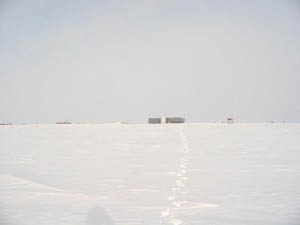
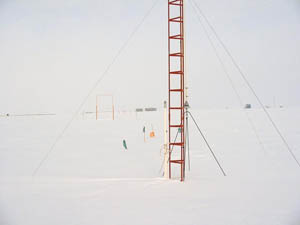
It's about a 1-mile hike from station out to the antenna field. Not many people get to hike out here, because science is "protected" -- as a result, I got to leave some solitary tracks in the snow, which I always enjoy seeing. You wouldn't guess it from the picture on the right, but the VLF antennas are actually quite tall -- 29.5 feet, to be exact, and they each have a 59-foot base. Only about 4 feet of the antennas are visible, meaning that about 98% (by area) is under snow and ice. The preamplifier is buried in a vault that goes all the way down that distance. One would surmise that the VLF antennas haven't been raised in about 25 years.
These VLF antennas are sensitive to signals with frequencies from ~500 Hz to ~32 kHz. They are single-turn magnetic loop antennas (supposed to be air-core, but now ice-core), meaning that the voltage induced at the terminals is proportional to the time-derivative of the magnetic field perpendicular to the plane of the triangle times the area of the loop. The electronics within the preamplifier essentially integrate to generate an output that is proportional to the magnetic field strength itself.
That's about it for today... If all goes well, I'll tell you about my trip back to New Zealand tomorrow night.
8 Feb 2010: South Pole Station to New Zealand
I could not upload my postings for the last few days. Things seem to be better now. Notice that there are a few days' worth of postings below....
Today was pretty much a travel day. I caught my plane this morning at South Pole, caught another one at McMurdo, and now here I am back in downtown Christchurch, about 12 hours later. I turned in my cold weather gear and re-packed for tomorrow's flight home. There seems to be a lot of painful re-packing on this trip, but there's no way around it.
Really, it's not 12 hours of flying from South Pole to Christchurch. It's about 3-4 hours from South Pole to McMurdo, where you wait for the second-leg plane to be packed up (no one knows why this one wasn't already set up by the time we got there, but that's the way things go). Today, this took about an hour. Then it's another 5 or 6 hours to Christchurch, where you go through customs (30 minutes), turn in your cold-weather gear (30 minutes), and catch a ride to your hotel (10 minutes). Separating your personal items from your cold-weather gear is painful, mostly because you have to re-pack everything for the 10th time, and by the time you get to Christchurch, it's late enough that the only places open serving food are bars. Still, the food served in bars here is pretty good -- you don't even have to go to a ritzy bar and you'll do just fine.
I leave for home tomorrow morning at about 11 am, and I expect to be in Gainesville around 9pm, on the same day. It's a wonderful thing, how a 34-hour flight turns into a 10-hour flight when you cross the international date line...
At any rate, there won't be a post tomorrow, but I'll try to provide a travel summary after I get home in about 2 days....
9 Feb 2010: Gainesville, Florida
I arrived back in Gainesville at about 8:30 pm last night, and I am back at work today. It is good to be home... My oldest son, Nikolas (3), stayed up late to greet me last night with a big hug and a kiss and a staunch request to chase him around the house. And I played with our twin one-year-olds (Sonja and Michael) this morning -- Sonja started walking while I was away, and all three of them seem to have doubled in size in the last 2 weeks.... At any rate, it's good to be home, and I'm glad the whole trip went off without much of a hitch. All the very best to you and yours.Signing off,
Robb
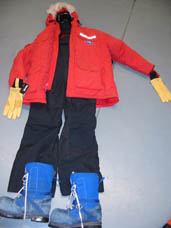
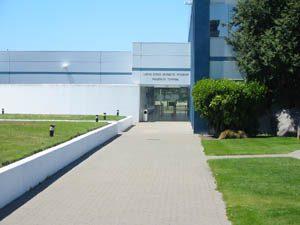
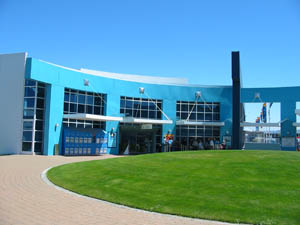
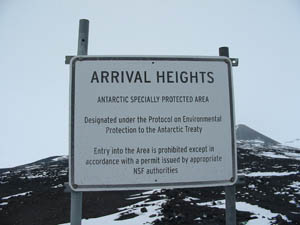
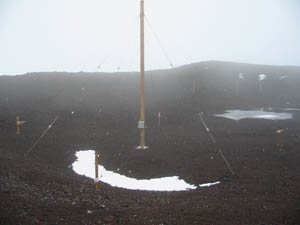
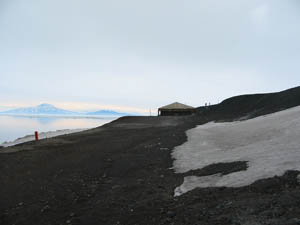
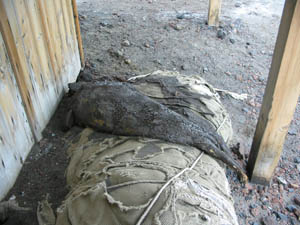
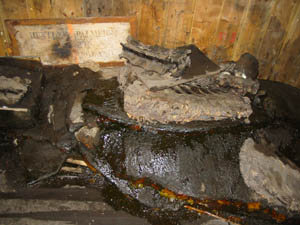
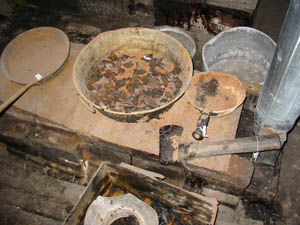
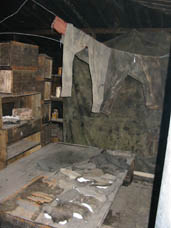
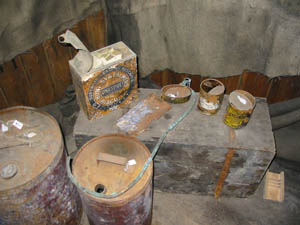
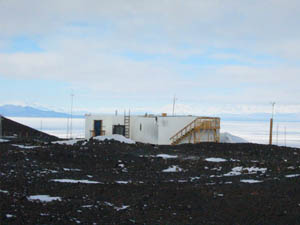
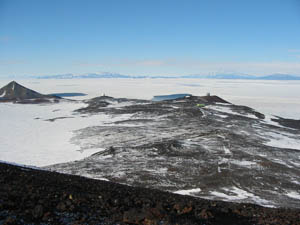
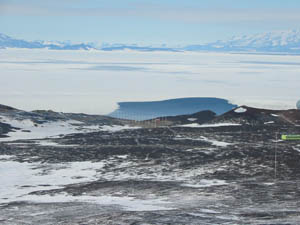
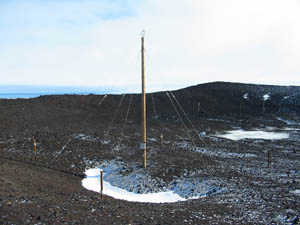
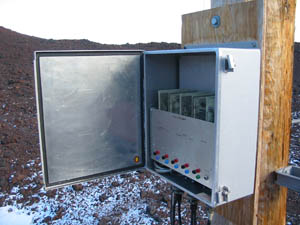
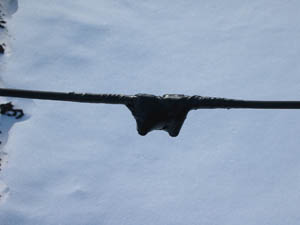
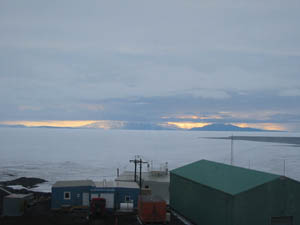
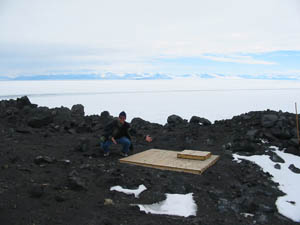
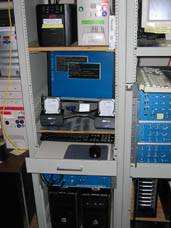
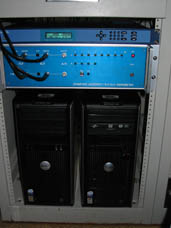
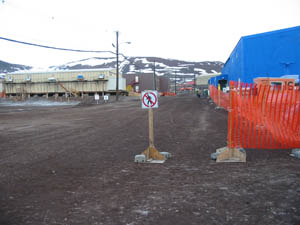
.jpg)
